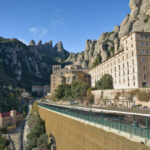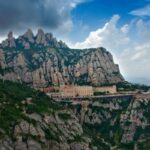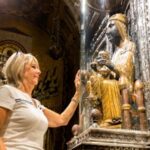
- The History and Significance of the Black Madonna in Montserrat Monastery
- Exploring the Mystical Origins of the Black Madonna
- The Spiritual Journey to Montserrat: A Pilgrimage to the Black Madonna
- Artistic Representations of the Black Madonna: Symbolism and Meaning
- Legends and Myths Surrounding the Black Madonna of Montserrat
- The Role of the Black Madonna in Catalan Culture and Heritage
The Montserrat Monastery, nestled in the stunning Catalan mountains, is home to one of the most revered and mysterious icons of the Christian world: the Black Madonna. This captivating figure, known as La Moreneta, has drawn pilgrims and tourists alike, eager to uncover the secrets and stories that surround her.
In this exploration of The Enigmatic Black Madonna: Unveiling the Secrets Inside Montserrat Monastery, we will delve into the rich history, cultural significance, and the myriad legends that envelop this sacred site. As we journey through the monastery's hallowed halls, the allure of the Black Madonna reveals a tapestry of faith, art, and devotion that continues to inspire awe.
The History and Significance of the Black Madonna in Montserrat Monastery
The Black Madonna, or La Moreneta, is not just a remarkable religious icon; she embodies a complex history that dates back to the early days of Christianity in Spain. Believed to have been discovered in the 9th century by a group of shepherds, her statue became an object of veneration almost immediately. This early discovery led to the establishment of the Montserrat Monastery, which became a significant pilgrimage site for the faithful seeking her blessings and intercession.
Over the centuries, the Black Madonna has transcended her religious roots, becoming a symbol of Catalan identity and culture. The monastery itself houses numerous artworks and relics, making it a treasure trove of religious and artistic heritage. Not only does the Black Madonna serve as a spiritual focal point, but she also represents the enduring connection between the people of Catalonia and their history, particularly during times of turmoil and resistance.
The legends surrounding the Black Madonna are equally fascinating, with tales of miraculous interventions and healings attributed to her presence. Pilgrims often recount personal stories of transformation and hope after visiting Montserrat. These narratives have solidified her status as a powerful figure in modern spirituality, inspiring countless individuals to embark on their own journeys of faith and self-discovery.
In summary, the Black Madonna of Montserrat is more than an icon; she is a testament to the rich tapestry of faith, history, and culture that defines this extraordinary site. The interplay of legend, art, and devotion surrounding La Moreneta continues to captivate the hearts and minds of those who seek to understand her significance. As we reflect on her legacy, we uncover not only the depths of religious devotion but also the enduring human spirit that seeks solace and meaning in the face of life's mysteries.
Exploring the Mystical Origins of the Black Madonna
The origins of the Black Madonna are steeped in mystery, intertwining elements of legend, spirituality, and history. The figure, often depicted with dark skin, is believed to represent both the earthly mother and the divine, embodying a universal connection that transcends cultural boundaries. Many scholars suggest that her origins may trace back to pre-Christian fertility goddesses, which were later adapted to fit into the Christian narrative.
Archaeological findings indicate that similar figures of Black Madonnas have appeared across Europe, each associated with unique local legends and beliefs. These icons often share common themes, such as miraculous healings and protection during perilous times, which have contributed to their widespread veneration. Some of the most notable attributes of these figures include:
- Healing powers: Many pilgrims attribute personal miracles to their devotion to the Black Madonna.
- Cultural symbolism: The figure often represents the resilience of communities, particularly during periods of strife.
- Artistic representations: The imagery of the Black Madonna has inspired countless artists throughout the centuries, reflecting her profound impact on culture.
As we explore the mystical origins of the Black Madonna, it becomes evident that she serves as a profound cultural and spiritual anchor for many. Each story and legend associated with her illuminates different facets of faith, showcasing how deeply intertwined spirituality is with the human experience. This rich tapestry of narratives helps to explain her enduring allure and the myriad reasons why she remains a focal point of pilgrimage and devotion.
Ultimately, the Black Madonna’s enigmatic presence encourages believers and seekers alike to ponder their own spiritual journeys. Her figure, shrouded in mystery and reverence, continues to inspire questions about identity, faith, and the profound connections we share with the divine. The quest to understand her origins is not merely an exploration of the past, but also a reflection on the ongoing journey of faith that resonates through generations.
The Spiritual Journey to Montserrat: A Pilgrimage to the Black Madonna
The spiritual journey to Montserrat is a transformative pilgrimage that attracts thousands of devotees each year. As they ascend the picturesque trails leading to the monastery, pilgrims often find themselves enveloped in the serene beauty of the Catalan landscape. This journey is not just a physical ascent, but a profound exploration of faith, identity, and connection with the divine. Visitors are encouraged to take part in various rituals and experiences that enhance their spiritual connection with the Black Madonna.
Upon arriving at Montserrat, pilgrims can engage in a variety of spiritual practices, each designed to deepen their connection to the Black Madonna and the sacred atmosphere of the monastery. Some of these include:
- Silent Reflection: Many choose to meditate before the Black Madonna, seeking personal insights and peace.
- Lighting Candles: A traditional act of devotion, lighting candles symbolizes prayers offered to La Moreneta.
- Participating in Mass: Attending services at the monastery provides a communal experience of worship and celebration.
- Guided Tours: These tours offer historical context and spiritual significance, enriching the understanding of the pilgrimage.
The significance of this pilgrimage extends beyond the individual; it fosters a sense of community among participants. As they share their stories and experiences, pilgrims often form lasting bonds that transcend geographical boundaries. This collective journey reinforces the idea that faith is a shared experience, uniting diverse individuals in their quest for understanding and belonging.
Ultimately, the pilgrimage to Montserrat is an invitation to embark on a deeper spiritual exploration. It challenges individuals to confront their beliefs, hopes, and fears, while also offering a sanctuary of solace and reflection. The experience of connecting with the Black Madonna serves as a powerful reminder of the enduring human quest for meaning and the divine.
Artistic Representations of the Black Madonna: Symbolism and Meaning
Artistic representations of the Black Madonna are rich in symbolism and meaning, reflecting her multifaceted role in both religious and cultural contexts. Often depicted with dark skin, she embodies a connection to the earth and the divine, representing the nurturing aspect of motherhood. This duality resonates with many believers, symbolizing both the human experience and transcendent spirituality, inviting contemplation on the nature of faith.
The imagery associated with the Black Madonna varies widely, each interpretation carrying its own unique significance. Common elements often found in these artworks include:
- Contrasting colors: The interplay of dark skin tones with vibrant garments emphasizes her connection to the divine while grounding her in the human experience.
- Child imagery: Frequently depicted holding the infant Jesus, this representation reflects themes of protection, care, and maternal love.
- Symbolic objects: Items like crowns or flowers often appear, symbolizing her royal status and connection to nature.
These artistic expressions serve not only as devotional objects but also as cultural artifacts that convey the stories and beliefs of the communities that venerate her. The Black Madonna has inspired countless artists across centuries, leading to a vibrant tradition of art that captures the essence of her mystery and power. This ongoing artistic journey showcases her profound impact, merging spiritual devotion with the creative human spirit.
Ultimately, the Black Madonna stands as a powerful icon whose artistic representations invite deeper reflection on themes of faith, identity, and the universal quest for understanding. Each artwork acts as a dialogue between the past and present, reminding us of our shared cultural heritage and the enduring nature of spirituality across different societies. Through these representations, her enigmatic presence continues to resonate, inspiring new generations to seek out her wisdom and guidance.
Legends and Myths Surrounding the Black Madonna of Montserrat
The legends surrounding the Black Madonna of Montserrat are as rich and diverse as the history of the monastery itself. One of the most captivating tales involves her miraculous discovery by shepherds in the 9th century, who claimed to have found her statue hidden in a cave. This event sparked a fervent devotion that attracted pilgrims seeking solace and healing, establishing Montserrat as a significant spiritual destination. Many believe that the Black Madonna's presence has led to countless healings, further enhancing her reputation as a divine protector.
Another popular legend speaks of the Black Madonna's ability to offer comfort during times of distress. During the Spanish Civil War, many sought refuge at Montserrat, believing that the Madonna would shield them from harm. This enduring belief has solidified the icon’s status as a symbol of hope and resilience, particularly amongst Catalans facing adversity. Such stories are not only deeply rooted in local culture but have woven themselves into the fabric of collective memory, reinforcing a sense of identity among the faithful.
Additionally, numerous myths surround the attributes of the Black Madonna. Some believe that she can grant wishes and that her image possesses special powers to ward off evil. Pilgrims often leave tokens or offerings to express gratitude for blessings received, creating a rich tapestry of personal stories and testimonies. The aura of the Black Madonna, intertwined with these legends, fosters an atmosphere of reverence and mystery that continues to draw visitors to Montserrat's sacred grounds.
In summary, the legends and myths surrounding the Black Madonna of Montserrat serve to enhance her enigmatic presence. They reflect a blend of faith, cultural identity, and the human desire for connection with the divine. As these stories are passed down through generations, they enrich the pilgrimage experience, inviting individuals to explore their own spiritual journeys while honoring the legacy of La Moreneta.
The Role of the Black Madonna in Catalan Culture and Heritage
The Black Madonna holds a unique position in the tapestry of Catalan culture, symbolizing not only religious devotion but also regional identity. She represents a merging of faith and heritage, embodying the spirit of the Catalan people. Her image can be found in various cultural expressions, from art and literature to music, reinforcing the idea that she is a vital part of the collective consciousness of Catalonia.
In community celebrations and local traditions, the Black Madonna is often honored in ways that reflect her significant role in Catalan life. Events include:
- Festivals: Celebrations dedicated to La Moreneta attract thousands, showcasing traditional music and dance.
- Processions: Pilgrimages to Montserrat often feature elaborate processions, allowing participants to express their devotion publicly.
- Artistic tributes: Local artists frequently create works inspired by her, contributing to a rich cultural dialogue.
Furthermore, the Black Madonna serves as a symbol of resilience, particularly during challenging historical periods for Catalonia. Her image has come to represent the strength and unity of the Catalan people, especially during times of oppression. This enduring legacy is reflected in the collective narratives shared by generations, which celebrate her role as both a spiritual guide and a guardian of Catalan heritage.
Ultimately, the Black Madonna is not merely a religious icon; she is woven into the very fabric of Catalan identity. As the embodiment of faith and cultural pride, she continues to inspire both spiritual journeys and artistic expressions, ensuring that her influence remains vibrant and enduring in the hearts of the Catalan people.
 Can I Move to Montserrat? Discover the Charm of this Picturesque Catalan Mountain Village
Can I Move to Montserrat? Discover the Charm of this Picturesque Catalan Mountain Village Breaking Free: Can Monks Ever Leave the Monastery?
Breaking Free: Can Monks Ever Leave the Monastery? Exploring Montserrat: Can You Conquer It in Just Half a Day?
Exploring Montserrat: Can You Conquer It in Just Half a Day? The Enigmatic Tale of the Black Madonna in Montserrat: Unraveling the Mystery
The Enigmatic Tale of the Black Madonna in Montserrat: Unraveling the Mystery Unveiling the Mystery: Can You Actually Touch the Black Madonna at Montserrat?
Unveiling the Mystery: Can You Actually Touch the Black Madonna at Montserrat?If you want to know other articles similar to The Enigmatic Black Madonna: Unveiling the Secrets Inside Montserrat Monastery you can visit the category WHERE YOU CAN GO.
Deja una respuesta










Read more!